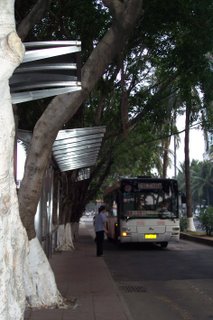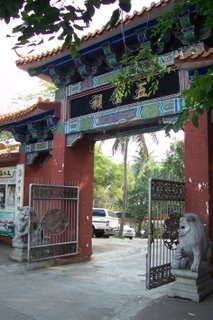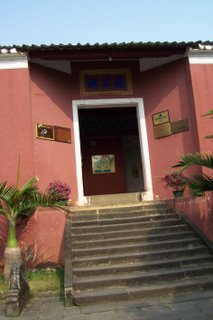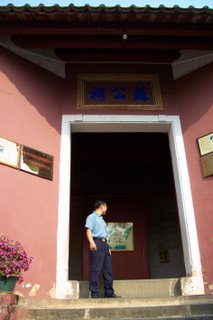
(12 Nov 2006, Hainan)
After the dim-sum breakfast, and after my cousin helped me find the much rare postcards of Hainan, my cousin, his wife and my first aunt were so hospitable that they agreed to take us to the Five Officials Temple.
My mother won't be quite keen on sight-seeing, knowing her. As such, it seems the choice of the place to sightsee was probably as a result of my preferences. I had asked my cousin the previous evening about if there is any place in Haikou where I could find out more about the history and heritage of Hainan. The Five Officials Temple was one of the places that he had recommended.
We walked towards a nearby bus-stop and took a bus to the Five Officials Temple. The journey took about twenty minutes. The bus that we took was quite interesting. Just before each bus-stop, there will be a recorded announcement announcing the name of each of the bus-stops. It appeared that each bus stop would be named according to the name of a nearby landmark.

Finally, we reached the Five Officals' Temple (in Mandarin: Wu3Gong1 Ci2). The temple was built in honour of five revered government officials - Li Deyu, Li Gang, Li Guang, Zhao Ding and Hu Quan - who were banished to Hainan Island in the Tang and Song dynasties (click to view source).

Admission was 20 RMB per person, which I felt was reasonable if I were to convert the admission fees to Singapore dollars. However, come to think about it, for the locals, 20 RMB could buy a person at least 8 to 10 bowls of noodles from a humble food stall.
Anyway, according to one of the brochures, the Five Officials' Temple is one historic site where one can comprehensively learn about the history, political and cultural development of Hainan. In order to learn about the Temple, I bought myself a booklet containing information on the Temple. The contents are written in Mandarin, and I haven't set aside any time to read that booklet from cover to cover though.
As I had foreseen, my mother decided not to join me, my dad, my cousin and his wife with the sightseeing. Instead, she and my first aunt found a spot to sit under a pavilion and they started chatting away. Perhaps I am a lady with few words generally, I wonder what made my mother have so much to talk about with my aunt that day. Anwyay, I love walking about and sightseeing, so I didn't bother too much about my mother as I knew she was alright with sitting down and chatting.
The Five Officials' Temple stands on a land that has an area of 66000 square metres (according to one of the brochures). I particularly like its scenic environment, so please pardon me if you were to see too many photos of it here.
My cousin served as our guide for the day. He said that he had attended a few guided tours about the Five Officials' Temple when he was a student.

 Ji Spring. Accordingly to what I could make out of the descriptions, Ji Spring was uncovered by chance in the year 1915 while enlarging the roads found within the Five Officials' Temple.
Ji Spring. Accordingly to what I could make out of the descriptions, Ji Spring was uncovered by chance in the year 1915 while enlarging the roads found within the Five Officials' Temple.
 Right here, my cousin shared with us about this Chinese idiom "Men Dang1 Hu4 Dui4" (which literally means finding a partner who is of equal social standing) and how it came about. The stone that you see in this photo right above is very closely related to this Chinese idiom.
Right here, my cousin shared with us about this Chinese idiom "Men Dang1 Hu4 Dui4" (which literally means finding a partner who is of equal social standing) and how it came about. The stone that you see in this photo right above is very closely related to this Chinese idiom. According to my cousin, the stone that you had see on the photo just before this should be placed approximately where he was standing.
According to my cousin, the stone that you had see on the photo just before this should be placed approximately where he was standing.It had been interesting and enriching to know more about how certain idioms in the Chinese language had came about.
More about the Five Officials' Temple in another post, if you care to wait.
**
Reference:
http://www.hainandiscovery.com/eng/region/haikou_sights2.htm
No comments:
Post a Comment